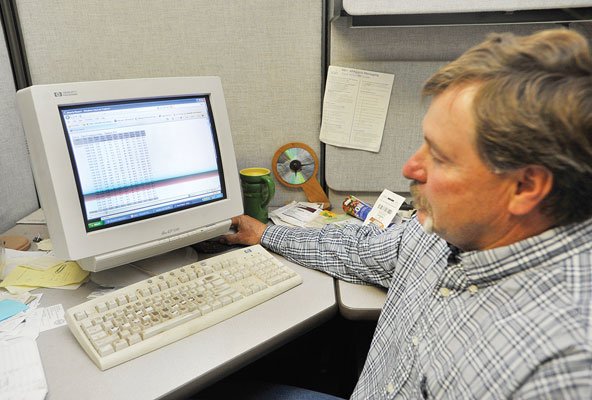To the naked eye, walking by the Clos LaChance winery on a sunny
afternoon when the vines are being watered may look like something
very typical. Yet below ground and recorded on a data system, this
watering session is anything but ordinary.
To the naked eye, walking by the Clos LaChance winery on a sunny afternoon when the vines are being watered may look like something very typical. Yet below ground and recorded on a data system, this watering session is anything but ordinary.
Clos LaChance along with nine other growers in Santa Clara County, are participating in a water efficiency program funded by the Santa Clara Valley Water District and run by the Santa Clara County Farm Bureau. Using high technology, including infrared cameras, pressure regulators and automated weather stations, growers are determining exactly how much water is needed for maximum crop yields and better water use methods.
Ben Scorsure, vineyard manager for Clos LaChance in San Martin, explained the different aspects of the program that has helped the winery for the past three seasons that it has participated in program.
A wireless data logger logs every irrigation application, how much time the irrigation runs for and the total flow of water in the nine-acre block the winery has been using for the program. Six moisture probes measure the amount of moisture in the soil, as well as emitters that test the pressure in water lines.
Scorsure can also log onto CIMIS, California Irrigation Management Information Service based in Gilroy, for reports on weather, wind speed, air temperature, humidity and evapotranspiration – or the amount of water that’s being evaporated from the soil.
These factors, and more, contribute to better water efficiency and how much water is needed in a given day.
“When the temperatures rise, we need to put on more irrigation, as it cools, in cooler weather, we use less water. We try to time the amount of irrigation to the amount that the plant needs and put it on a regular schedule,” said Scorsure.
Clos LaChance found a pressure problem in the 2009 season and they were able to correct it for the 2010 season. They’ve also taken the statistics from the nine-acre pilot plot and have applied it to the rest of the 140 acres of land, Scorsure said.
“Water is a scarce commodity. And we’re good stewards of that commodity,” Scorsure said. “Ultimately, if you’re using less water, and using water more efficiently, there’s a lower cost associated with that.”
Scorsure says they generally have three-hour watering sets per day, using a drip system, which uses three gallons of water per vine. With about 5,445 vines in the nine-acre block, that’s 16,335 gallons of water.
Jennifer Willaims, director of the Farm Bureau, said the benefits of the program do not end at the program’s collective goal of 80 percent water efficiency use.
“Anytime we’re investing resources and making use of our current resources that’s a good thing,” she said. “Specifically for this program, there are a lot of benefits beyond just water efficiency: the reduction of fertilizer, better fruit quality, better yield, less cracking and better sugar content.”
Sherrie’s Tomatoes in Gilroy has noticed an overall increase in the quality of their product during the program. Mike Kennedy took random samples to measure the sugar levels of the heirloom tomatoes they grow in their two-acre plot specifically for this program. They noticed a higher level of sugar, and a better quality fruit. For Kennedy, he also learned with moisture probes the way their tomato plants absorb water.
“You could push a button and it would tell you what the soil moisture was. It gave you an idea of how fast the soil was drying out. On a warmer day, the plant draws more water more quickly, it told us,” Kennedy said. “We want to keep the moisture level as constant as we could.”
Michael Cahn is the irrigation advisor with the University of California Cooperative Extension that has been working one-on-one with growers to recommend new practices during the program. Uniformity in the irrigation systems has been one of the important factors to avoid over or under watering.
“In many cases, growers have reasons why they’re doing what they’re doing, and have been slow to use new technologies. For some reason the grower might not want to use them and we have to politely introduce them to new things” Cahn said.
Cahn would chat with growers, set goals and slowly implement new methods for better irrigation use. He gave the example of a grower in Gilroy who was using too much water for his celery. Yet, with the data reports and the weather inclinations through the CIMIS site, they were able to help him set up an adjusted system that has now reduced the amount of water use.
Bob Siegfried, a civil engineer of agriculture with the Santa Clara Valley Water District said the overall program costs about $110,000 per year, roughly $10,000 per grower, per year. Distribution uniformity analysis – which basically measures how evenly water goes into fields – can cost up to $1,000 per analysis alone and is conducted by Cahn. Siegfried says every grower has met the 80 percent or more water efficiency goal and it is up to the water district board to decide the fate of this program.












